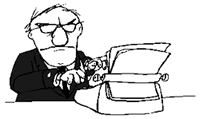 
Unit
2 - Theatre History
Module
1: Understanding Historical Context
Lesson
4
- Realism & Contemporary Theatre
Introduction:
The purpose of these activities is to promote student discussion
of modern theatre, from Ibsen to Tremblay. Students use discussion,
reading, and research to explore the many directions theatre has
taken.
Objectives:
- to understand how theatre can influence the society in which
it is created
- to understand that theatre, past and present, can teach us about
ourselves
- to understand how the theatre elements such as focus, tension,
contrast and symbol contribute to a play
- to follow classroom routines and procedures
- to initiate out-of-class activities to support in-class work
Resources:
(pdf) Background notes
for theatre history unit; Plays from the period.
CELs:
C, CCT
Components:
Creative/Productive, Cultural/Historical, Critical/Responsive
 |
This icon indicates
an advanced print resource you can refer to for more in depth
research information. It has been provided courtesy of Dr.
Moira Day, University of Saskatchewan, Theatre Department.
|
Activities:
Activity
1 - Reading Historical Background Notes:
Students should read the notes and save a copy for their binders
by printing a paper copy(5 min.).

Activity
2 - Jigsaw Activity
Use the list
below or select from plays available to your students, and form
groups for a jigsaw exercise. Each group reads a play and then reports
back to the class.
Michelle
Tremblay
"For the Pleasure of Seeing Her Again" |
Oscar
Wilde
"The Importance of Being Earnest" |
Samuel
Beckett
"Waiting for Godot" |
Arthur
Miller
"The Death of a Salesman" |
Connie
Gault
"Soft Eclipse"
(Saskatchewan playwright) |
Eugene
Ionesco
"The Bald Soprano" |
- The students
read the play and discuss it. Set specific focus areas such as
writing style, topic, theme, focus, contrast, symbol and set style.
(30 min. for the discussion)
- The groups
must find out some information about the playwright by using an
advanced search on-line (biographical, other plays of note, influence
on theatre). (25 min.)
- As an expert
group, students should decide how one scene in their play should
be presented (set, lighting, music, costume). (15 min)
- The expert
groups break up, and the new experts join their home groups. Once
in the home groups, the students present the information they
have learned to the group, and everyone writes it down. The information
may then become notes for an open-book test (55 min. +)
- Circulate
during the home group meetings and ask guiding questions to encourage
student exploration of key ideas.
- Following
the group work, review for a possible open book test.
Instructional
Strategies:
Homework, Computer assisted instruction, Jigsaw, Cooperative learning
groups
Evaluation:
The teacher may evaluate individual participation in jigsaw
exercise and construct an open-book test on the lesson material.
Alternative
On-line Activity:
Note
taking requires no changes. Expert groups can present information
by e-mailing it to the members of their home groups, and exchanging
additional e-mails to discuss questions. Teacher-made tests can
be administered at a remote location by the classroom teachers
there.
Next
Lesson / Student Lesson
/ Previous Lesson
|









